Who should be writing copy for chatbots?
A copywriter or a programmer?
If I’d take a wild guess, you’ll probably say programmer.
Your reason might be, “Simply because they developed the bot.”
But wait.
Slow your roll for a minute and consider why you are creating a chatbot to begin with.
For most individuals running or managing a business, the sole purpose of creating chatbots is to:
- Save time, manpower, and costs.
- Improve customer engagement and onboarding around the clock.
- Answer customer queries automatically.
- Create a delightful customer experience.
As a matter of fact, chatbots help companies save up to 30% on customer support costs.
But most of us aren’t tech wizards. That’s alright.
If you need your chatbot to do sophisticated things, you definitely need a programmer to work their magic.
Unfortunately, developing your chatbot is just one piece of the pie. Designing it with the intent of communicating and converting is a whole different story.
If you are planning on creating a chatbot for your business, hire a writer. You’ll thank yourself later.
Chatbots engage in critical conversations with users. You need a copywriter to fill in those titbits for you. Otherwise, you’ll offer generic and one-to-many messages.
They need to be personalized. Fun. Unique. 👍
Follow along to learn the fundamentals of chatbots and how to write chatbot scripts that convert like mad.
What are Chatbots?
According to Expert System, “A chatbot is artificial intelligence (AI) software that can simulate a conversation (or a chat) with a user in a natural language through messaging applications, websites, mobile apps, or through the telephone.”
That’s a whole lot of tech jargon. Let me break it down.
Imagine a chatbot as the person that takes your order in a restaurant but doesn’t make the food.
They greet you, ask you what you’d like, and fulfill your needs. (Kind of like a butler.)
Chatbots carry on a conversation in place of a real person.
In fact, 80% of consumers who have engaged with a chatbot say it was an overall positive experience.
We also live in a world of likes, tweets, Instagram stories but by heart are social creatures.
Doesn’t it make sense to bring back the human element in your marketing then?
I think so. And so do the 69% of consumers who prefer to use chatbots for the speed and ease of use they offer.
That brings me to my next point.
Why do I need a chatbot?
Let’s be real. You’re human.
Unless you drink enough coffee to get an entire Olympic team banned, you can’t always be there for your customers 24/7.
That’s where chatbots save the day.
58% of B2B companies and 42% of B2C companies use a chatbot on their websites.
It’s becoming the norm. The majority. You don’t want to get left behind while competitors are gaining an edge.
When’s the last time you visited a website and a chat box popped up? It was yesterday for me.
Don’t freak out if you don’t have a chatbot yet or your copy is stale.
Here are some platforms you can check out:
Let me talk a bit more about how chatbots work.
How do Chatbots work?
Chatbots work by matching the best possible answers to messages sent by the user.
Depending on which page or behaviour activates the chatbot, messaging and how it engages with users changes accordingly.
This is to offer the most tailored and helpful experience.
AI-powered chatbots take the responses and chat flows from every interaction and use machine learning to create high-performing scripts and templates. 🤖
It’s a complex algorithm and your coffee might go cold if I dive into the details.
Nonetheless, the purpose of a chatbot is to offer a simple, direct, and easy-to-understand answer for every query.
Some chatbots are remarkably amazing.
They create an authentic conversational experience that makes you question your thoughts of whether you are talking to a human or a bot.
Take Poncho for an example:
Now that’s the kind of chatbot users would love to engage with!
The humour, friendliness, and conversational tone of Poncho makes you forget that you are actually talking to a bot.
And that alone—makes the difference. 👌
On the other hand, some chatbots are not doing a very good job. From the first three lines of the conversation, you can pretty much spot them.
You’ve probably at one time had to chat with customer support or had a conversation via live chat.
Within the first 30 seconds, you’ll notice you’re having an awkward, vague, sneaky, and weird conversation with a “person” that actually might be a robot.
Something like this:
Ewww! This sucks!
There’s no excuse for it.
Heck, there are over 300 different chatbot platforms nowadays that’ll do it for you. All you have to do is simply drag-and-drop and you are good to go.
The only way to avoid the former is with amazing copywriting…
What is Chatbot copywriting?
Chatbot copywriting is a form of writing that focuses on developing conversation templates for—you guessed it—chatbots.
They need to have a seamless conversation flow that’s human-like in nature.
…Answers questions quickly.
…Provides resources and links.
…Adjusts according to the user’s behaviour.
Think about how you talk to Alexa, Siri, Bixby, or Google Assistant. It’s like a friend speaking to a friend.
“Hey Alexa, play me All of Me by John Legend.”
“Hey Siri, what appointments do I have scheduled for today?”
“Hey Google, set my alarm for 7:00 AM.”
You probably won’t yell at your friend to play you All of Me by John Legend—unless he’s the DJ at your wedding—but you get my point.

A survey involving 7,000 consumers discovered that people expect chatbots to have conversational abilities at the human-level including humour and intelligence.
This requires a skilled copywriter.
How well your chatbot interacts with customers impacts branding too.
First impressions matter.
You owe it to your business and customers to have fun and customized chatbot scripts.
That brings me to my next point.
Choosing a chatbot copywriter
Let’s take a trip down memory lane.
Think about the last time you received good customer service. 🤔
You thought, “Wow. I’ve never been treated that well before.”
You told friends and family. It made you loyal to that brand.
I bet they offered a mix of resourcefulness, professionalism, and fun.
A talented copywriter will encapsulate all of these traits into an automated chat.
When hiring a chatbot copywriter, I suggest first looking for experience with chatbots.
This can be writing chatbot templates, developing them, or using them on their personal website.
They need to understand how to speak to customers in a way that resonates with them and moves them from discovery to conversion in the quickest manner.
Please, please, please provide copywriters with a buyer persona to make their life easier.
This is a personification of your ideal customer summarizing their values, beliefs, questions, pain points, and demographics. It looks like this:
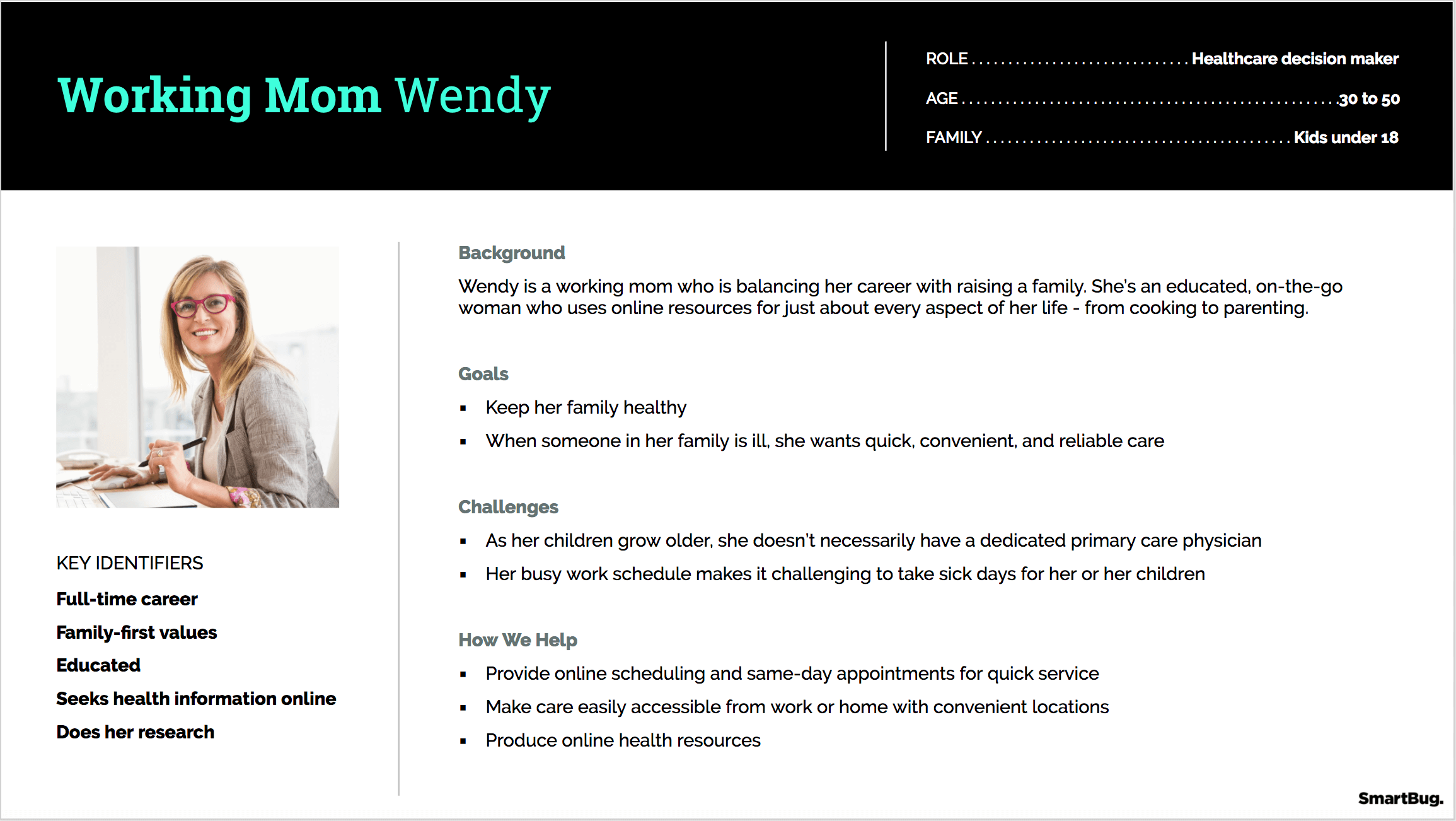
It helps copywriters for hire like myself to write material that matches the way readers speak.
Chatbot copywriters ideally will have an impressive portfolio and track record too.
I don’t mind giving some love to the small guys but if you want a big ROI, you need to invest in a professional writer. Case studies are a plus.
Let’s move onto the meat and potatoes of today’s blog post: writing chatbot scripts!
Chatbot copywriting strategies
Before writing your chatbot script you need to have a conversational plan set out.
With a conversational plan, you are able to modify conversations between your chatbot and humans in order to resemble an actual conversation.
It shouldn’t be dry as cardboard. Throw in some emojis and gifs for business’ sake!
Below are seven important guidelines that will keep you on track to writing high-performance chatbot conversations.
Define your chatbot’s primary purpose
Everything needs purpose and reason. Otherwise, it becomes arbitrary.
Naturally, a chatbot needs a purpose.
Don’t just slap one on your website and forget about it. 👎
That’s not going to do anything but tick off users.
Instead, define a goal and KPIs.
The objective may be improving customer service or moving users through the sales funnel.
This will impact how the chatbot is set up and the sales copy is written.
You will also need key performance indicators. Think of them as a North Star. It tells you if you’re moving in the right direction. ⭐
They include:
- Chatbot activity
- Bounce rate
- Retention rate
- Chatbot responses
- Chatbot conversation length
- Chatbot click-through rate
- Goal completion rate
- Non-response rate
Determining these will help you measure the effectiveness of a chatbot. It needs to move the needle after all.
Create a personality
Chatbots shouldn’t be boring and bland.
They need to have a personality. Some flair.
Users should feel like they’re interacting with a fun assistant.
You can do this in one of two ways.
The first is to give your bot a name and avatar.
I like how MobileMonkey does this:
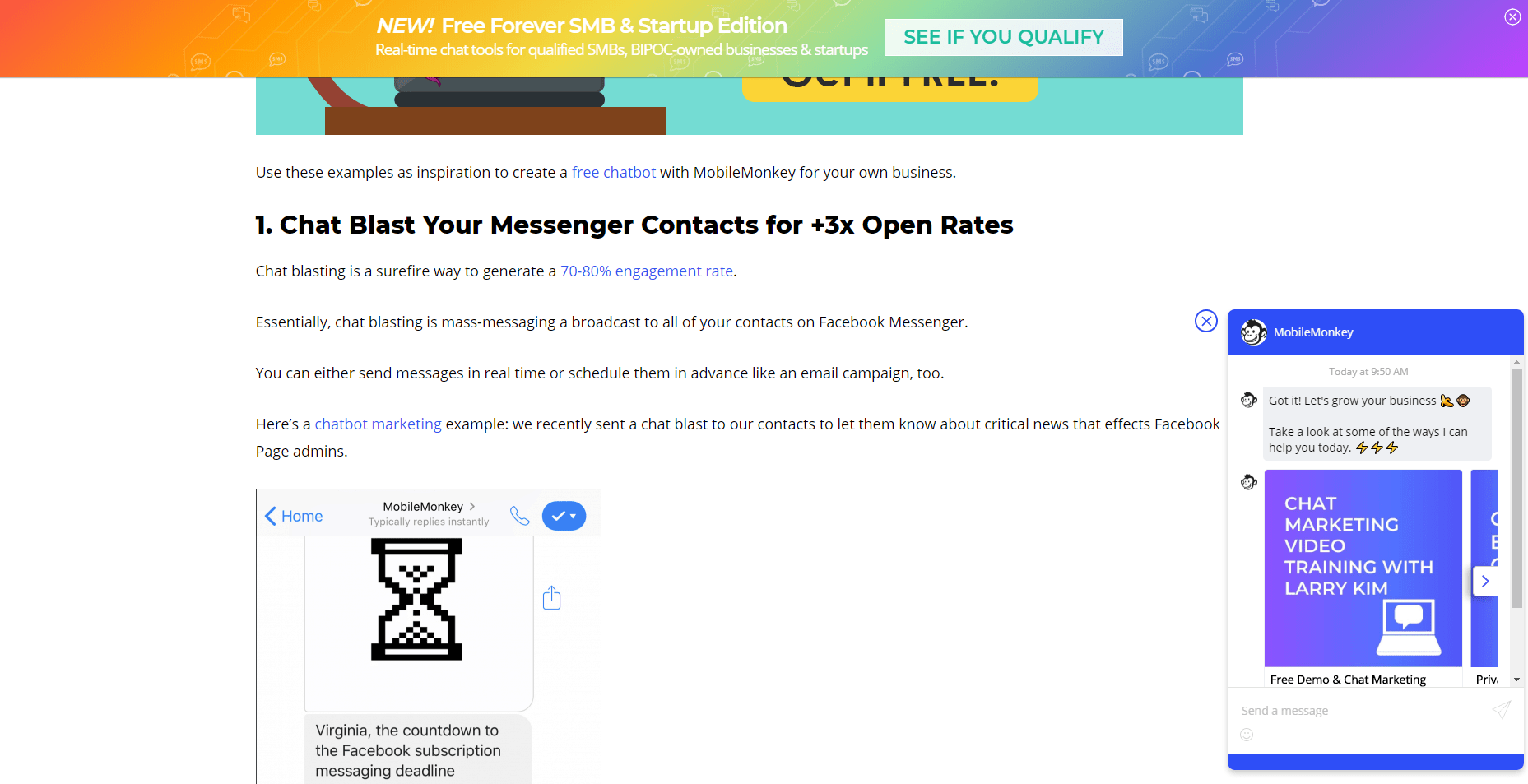
It is a fun and casual way to approach chatbots. It’s ideal for software and tech companies because it matches branding.
Don’t be afraid to add memes, gifs, and emojis.
Everyone and their mom uses them.
Alternatively, you can add the photo of a customer service rep that will be handling the conversation once it reaches a certain point and requires a human to handle the conversation.
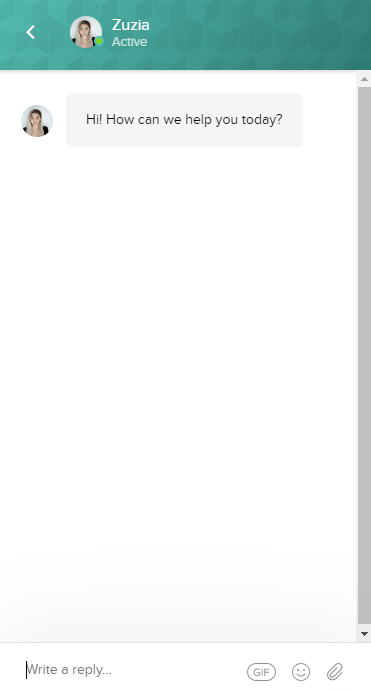
Keep it short and sweet
C’mon! we’re in 2020. No one sends walls of texts anymore.
People are crunched for time. They need quick answers.
That’s why chatbot copywriting scripts should consist of short and sweet messages.
They get the job done. They don’t waste the user’s time.
Look how MongoDB uses a casual and convenient chatbot:
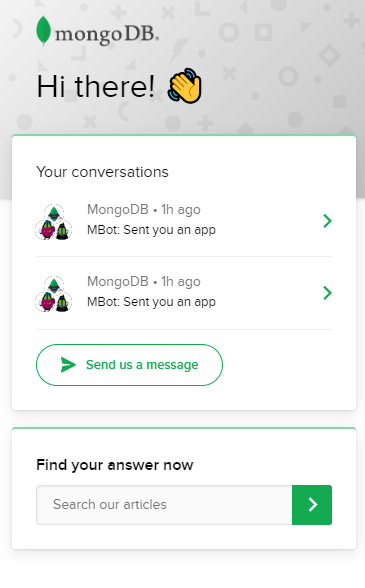
It greets you with the option to find an answer in their article database or by asking a question.
Clicking “Send us a message” gives you several options.
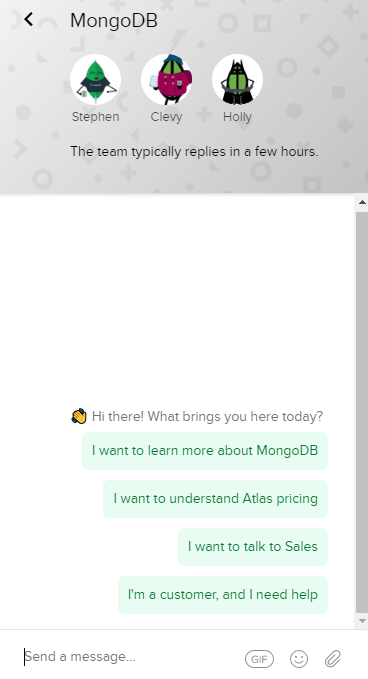
Clicking one automatically prompts the chatbot to deliver relevant answers and website links.
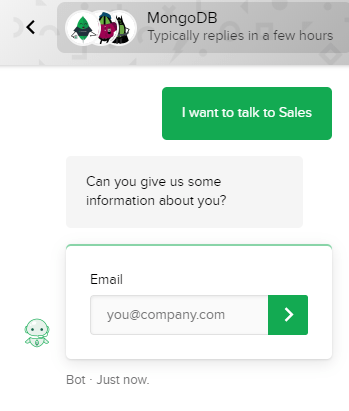
Don’t send users novel-length responses or it will overwhelm them.
Perform user testing
You won’t know how well your chatbot performs or interacts with users without testing.
Think of yourself like a scientist in a lab.
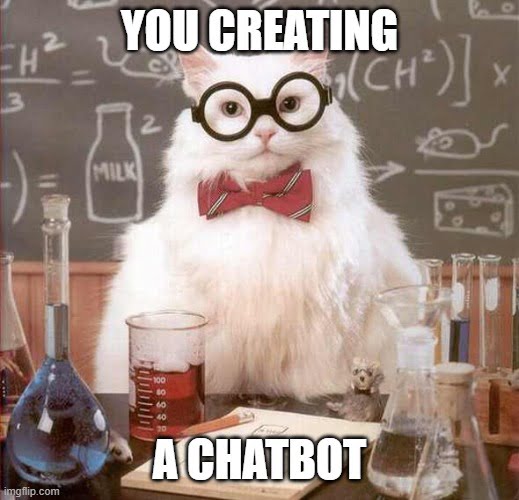
You tinker with different elements of the chatbot copy until it’s perfect.
Begin by releasing an MVP.
This is a simple version of the chatbot with basic scripts and chat flows.
Observe your KPIs. Are people using the chatbot? Moving deeper into your website? Converting?
Cool. Keep going.
You can then develop the areas of the chatbot that get attention and either optimize or remove the parts that don’t.
Have a clear CTA
Chatbots need to do something. Not just look nice.
That’s why having clear calls to action are critical for success.
This helps guide users to a solution for their inquiry and also move them closer to the point of sale.
The first call to action should be something along the lines of “Let me know how I can help you” to prompt an initial response.
Then, ask further questions and state what they should do next depending on the conversation flow.
Interested in services? Tell them to read your services page.
Looking for a certain product? Forward them to the correct category page.
You get my point.
Always be pushing them towards the end of the funnel and where they want to be.
Final thoughts on chatbot copywriting
Don’t sweat it when you are finding it difficult in writing or fine-tuning chatbot conversations.
Begin by choosing a chatbot solution like the ones I mentioned.
Then, work on creating a basic version of the chatbot that provides foundational answers and information.
Begin split testing and experimenting to find winning combinations of sales copy and chat flows.
Have a clear purpose in mind such as generating sales, improving customer support reviews, or otherwise. Set appropriate KPIs with this in mind.
Create a personality to make the bot more interactive and fun. Name it after me if you’d like. 😉
Messages should be short and sweet to respect the user’s time.
Every interaction needs to end with a clear CTA to maximize engagement as well.
What are your thoughts on what makes successful chatbots?
Let me know what you think.
Guest post contributed by
I’m a direct response copywriter for SaaS companies and Tech Startups. Basically the sorta guy cracking his knuckles to write words that grabs attention, gets people engaged, and delivers results.















